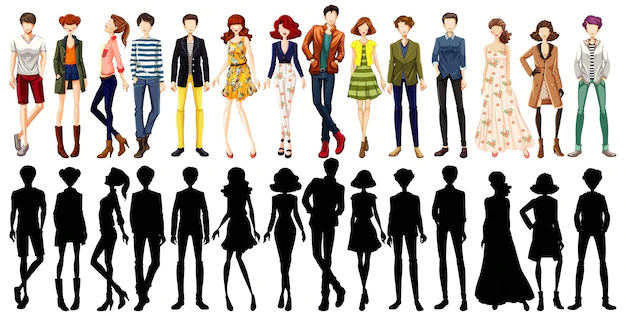Flattering Swimsuits: A Comprehensive Guide to Achieving the Perfect Fit
The selection of swimwear significantly impacts an individual's comfort and self-assurance during summer activities. This guide provides a structured approach to swimsuit selection, incorporating principles of body image, fashion psychology, and consumer behavior to assist in identifying and acquiring a flattering and comfortable swimsuit.
Body Shape Analysis: The Foundation of Swimsuit Selection
Understanding one's body shape—classifiable using somatotypes like hourglass, pear (gynoid), apple (android), rectangle, and inverted triangle—is paramount. This foundational step allows for the application of principles from the field of fashion psychology, which emphasizes the importance of aligning clothing choices with body type to maximize perceived attractiveness and self-esteem. Each body type presents unique opportunities for accentuating positive attributes and minimizing perceived flaws, directly affecting an individual's confidence levels (e.g., the use of strategic ruching in apple body types to create the illusion of a smaller waistline). This approach is a direct application of the principle of visual perception and its impact on self-perception.
Strategic Swimsuit Selection: Emphasizing Assets and Minimizing Perceived Flaws
Applying the principles of body shape analysis, the next stage involves strategically selecting swimsuit features to enhance favorable attributes and minimize areas of concern. For instance, an hourglass figure benefits from swimsuits that accentuate the waist, while a pear shape might benefit from swimsuits that balance the proportions through the use of darker colors or visual details in the lower body. This process leverages the Gestalt principles of perception, particularly the principles of figure-ground and closure. The strategic application of color, pattern, and cut helps the viewer (and the wearer) organize visual information in a way that highlights desirable features and minimizes others, thereby contributing to an enhanced self-image.
The Influence of Color and Pattern: Manipulating Visual Perception
Color psychology and the principles of visual perception play a critical role in shaping the overall visual impact of a swimsuit. Darker colors, such as navy or black, generally create a slimming effect, while brighter colors and bold patterns draw attention. This effect is based on the principles of simultaneous contrast and the ability of colors to manipulate the perception of size and shape. Furthermore, strategically used patterns – such as vertical stripes for a lengthening effect and horizontal stripes to create the illusion of curves – can subtly reshape the perceived body silhouette. Color choices should also complement skin tone for a more harmonious and radiant overall look, aligning with the principles of color harmony and their relationship to personal aesthetics.
Fit and Support: Prioritizing Comfort and Confidence
Proper fit and support are crucial, particularly for individuals with larger busts. Swimsuits featuring underwire, adjustable straps, or built-in cups provide superior support and enhance comfort. The importance of an appropriate fit cannot be overstated; it contributes directly to comfort and confidence. Discomfort stemming from ill-fitting swimwear negatively impacts body image and overall self-esteem, supporting the crucial role that physical comfort plays in psychological well-being. A well-fitting swimsuit thus functions as more than just clothing—it becomes a facilitator of self-confidence.
Exploring Diverse Styles: Optimizing Choice for Body Type and Personal Preference
A wide variety of swimsuit styles cater to different body types and personal preferences. One-piece swimsuits offer versatility and can be styled with cutouts or high-cut legs for a figure-flattering effect. Two-piece swimsuits, including those with high-waisted bottoms for tummy control, allow for more individualized fit. The selection should align with both the principles of body shape analysis and personal style preferences, underscoring the importance of individual expression and comfort in selecting swimwear. One-shoulder designs, for instance, offer a universally flattering and stylish option, demonstrating the intersection of fashion trends and body-positive design choices.
Swim Dresses and Cover-Ups: Enhancing Versatility and Coverage
Swim dresses and cover-ups offer additional coverage and style options. They provide enhanced coverage around the hips and thighs, potentially enhancing comfort and self-confidence in individuals seeking greater modesty. Cover-ups such as sarongs add versatility and allow for effortless transitions between sunbathing and other activities, reflecting the evolving demands of contemporary swimwear needs.
The Importance of In-Person Try-On: Ensuring Optimal Fit and Comfort
Prior to purchasing, trying on swimwear is crucial. Sizing variations across brands necessitate trying multiple options to ensure a perfect fit. This step is an essential part of the consumer decision-making process, emphasizing the tangible and experiential elements of product selection—demonstrating how sensory perception and trial before purchase significantly influence the final choice and overall satisfaction with the product.
Confidence: The Ultimate Accessory
Ultimately, confidence is the most flattering asset. Embracing one's body and celebrating individuality fosters self-acceptance and boosts self-esteem. This attitude positively influences how one presents oneself, regardless of the swimsuit chosen. The concept of body positivity directly challenges the pervasive pressures of unrealistic beauty standards and promotes a holistic approach to self-image, emphasizing the intrinsic value of self-worth independent of physical appearance.
Conclusion and Recommendations
Selecting a flattering swimsuit involves a multi-faceted approach, integrating principles of body shape analysis, color psychology, visual perception, and personal style. By understanding one's body type and employing strategic choices in color, pattern, and fit, individuals can select swimwear that enhances their confidence and comfort. Further research could explore the long-term impact of positive body image on mental and emotional well-being in relation to swimwear selection and summer activities. The findings of this guide can be applied to various aspects of clothing selection and can contribute to a more positive and informed approach towards personal style and body image.
Reader Pool: How might incorporating virtual try-on technology impact the swimsuit selection process and consumer satisfaction, and what are the potential ethical considerations surrounding its use?
```



